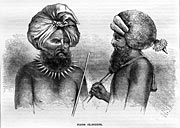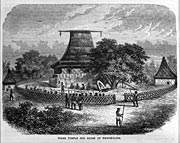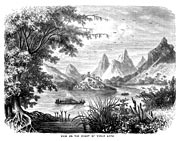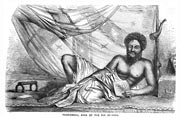| "Fijian Islanders" p.152
This is a copy of the illustration facing p.256 of Williams. The fact that it is reversed here is a result of the wood-engraver copying it onto his woodblock exactly from the lithograph in the original book. As a result, when printed, his version appeared in reverse. In this version, the man on the left wears a white barkcloth i-sala hairscarf, a chief's insignia, and appears also to be carrying a chief's i-titoko or staff of office (not in the original). His face has partly been painted white (vermilion in the original), and he wears what is meant to be a wasekaseka split-whaletooth gorget round his neck. In the original this is not too well drawn either, the teeth being too short, which is exaggerated here. The man on the right wears a two-tone wig (tinted red in the original) of human hair (ulumate) which has braids that hang down his back, his face is painted with white patterns (red in the original), and he carries a totokia beaked battle-hammer or pandanus club (often incorrectly called a pineapple club) over his shoulder. Actually, to me speaking as an artist and a printmaker, this is quite a creditable translation from one medium to the other, the changes handled with very little loss of the feel of the original. Neither the lithographer of the Williams plate, nor the wood-engraver here, had of course ever seen a Fijian, so it is rather remarkable that we are still able to get a good sense of what they would have looked like to Williams, the original portraitist (he did his own drawings). |
|
|
"Fijian temple and scene of cannibalism" p.153 This is a copy of the engraving of Na Vata ni Tawake on Bau, as illustrated in Calvert p.291, and all of the remarks I made about that image are also applicable to this. This is an inferior piece of work to the Calvert original. The drawing is not as good here, nor did the wood-engraver have such delicacy at his command. But the original composition was so striking, and scene so arresting, that it still remains a remarkable image. |
|
| "Strangers' house or inn in Fiji Islands" p.162
This picture is not from Williams or Clavert, and I do not know the original authorship of it. The stangers' house is called burenisä, and this would have been a remarkably large and fine one. The depiction of two men with their backs to us and apparently naked is totally fanciful. Total nakedness was anathema to Fijians, both men and women, long before missionaries decreed their (to Wetern eyes) scant dress as nakedness. Neither men nor women would allow themselves to appear in company that way, even among members of their own sex. |
|
| "View on the coast of Vanua Levu" p.169
As with the previous picture, this is not from Williams or Calvert, and its authorship is unknown to me. It shows a scene with impossibly tall sharp peaks, possibly drawn from a scene in Macuata, on the north coast of Vanualevu. A large outrigger, or camakau, sails quietly across the bay, presumably toward the island on which a substantial village stands. The very tall building on the hilltop on the island is the burekalou, or temple to the principal god of the place. |
|
|
"Thakombau, king of the Fiji Islands" p.170 Like the portrait heads on p.152, this is taken from a colour lithograph in Williams, in this case the frontispiece. Also like the heads, it is reversed from the original, and for the same reason. It has suffered a little in translation, the likeness to Cakobau having been sacrificed by the wood engraver who has given him an Arab cast of features — perhaps the only non-Europeans he had ever seen. In other respects, it is, like the portrait heads, quite a creditable transformation from one medium to another. In its original form, this is probably the most-reproduced picture of Cakobau, drawn at the height of his powers and long before the events that would see him dubbed "King of Fiji" by the European-inspired government set up in Levuka in 1871. Certainly Williams bestowed no such title on him, and nor did any of his fellow Fijians. He was the Vunivalu or warrior-chief of his island kingdom of Bau, and certainly at the time this portrait was drawn was already one of the most powerful men in the country. |




